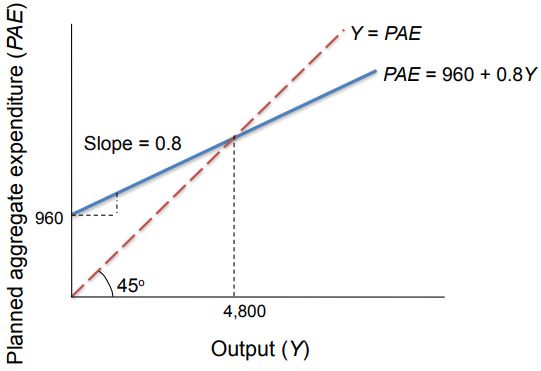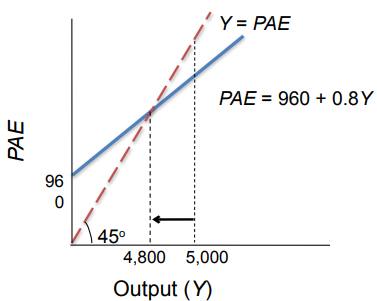Spending and Output in the Short Run
1/27
There's no tags or description
Looks like no tags are added yet.
Name | Mastery | Learn | Test | Matching | Spaced |
|---|
No study sessions yet.
28 Terms
The Keynesian Model
Building block for current theories of short-run economic fluctuations and stabilization policies
In the short run, firms meet demand at preset prices
Firms typically set a price and meet the demand at that price in the short run
Firms change prices when the marginal benefits exceed the marginal costs
What has Technology reduced?
menu costs
bar codes and scanners reduce costs of changing prices in the store
online surveys
Planned Aggregate Expenditure (PAE)
total planned spending on final goods and services
Actual spending equals planned spending for
Consumption
Government purchases of final goods and services
Net exports
4 Components of PAE
Consumption (C) by households
Investment (I) is planned spending by domestic firms on new capital goods
Government purchases (G) are made by federal, state, and local governments
Net exports (NX) equals exports minus imports
PAE Formula
PAE = C + IP + G + NX
2 Dynamic Patterns in the Economy
Declines in production lead to reduced spending
Reductions in spending lead to declines in production and income
Consumption Expenditure
Accounts for two-thirds of total spending
Powerful determinant of planned aggregate expenditure
Includes purchases of goods, services, and consumer durables, but not new houses
Rent is considered a service
C depends on disposable income: the after-tax amount of income that people are able to spend, (Y – T)
Consumption Function
An equation relating planned consumption (C) to its determinants, notably disposable income (Y –T)
C = C + (mpc) (Y – T),
where C is autonomous consumption
marginal propensity to consume (mpc) is the increase in consumption spending when disposable income increases by $1
0 < mpc < 1
(Y – T) is disposable income
Output plus government transfers minus taxes
Main determinant of consumption spending
Short-Run Equilibrium
the level of output at which planned spending is equal to output
no change in output as long as prices are constant
can be written Y = PAE

Output Greater then Equilibrium Example
Suppose output reaches 5,000 – Planned spending is less than output – Unplanned inventory increases – Businesses slow down production – Output goes down
Suppose output is only 4,500 – Planned spending is more than total output – Unplanned inventory decreases – Businesses speed up production – Output goes up

Income-Expenditure Multiplier
shows the effect of a one-unit increase in autonomous expenditure on short-run equilibrium output
Income-Expenditure Multiplier Example
Initial planned expenditure = 960 + 0.8Y
New planned expenditure = 950 + 0.8Y
The 10-unit drop in C implied a 10 unit drop in autonomous expenditure
Equilibrium changed from $4,800 to $4,750
A $10 change in autonomous expenditures caused a $50 change in output
Multiplier = 5
The larger the MPC, the greater the multiplier
Stabilisation Policy
Government policies that are used to affect planned aggregate expenditure, with the objective of eliminating output gaps
Expansionary policies increase planned expenditure
Contractionary policies decrease planned expenditure
Fiscal policy uses changes in government spending, transfers, or taxes
Monetary policy uses changes in the money supply
The Tools of Fiscal Policy
Government spending - Direct effect on PAE
Taxation - Indirect effect on PAE
Transfer payments - Indirect effect on PAE
Discretionary Fiscal Policy
Government decisions to change:
Government spending (G) - Direct effect on PAE
Net taxes (T) - Indirect effect on PAE
Both change the government deficit (G – T)
Government Spending
part of planned spending
changes will directly affect planned aggregate expenditures
Government Spending Example
Suppose planned spending decreases $10 from Y = 960 + 0.8Y to Y = 950 + 0.8Y
Equilibrium Y decreases from $4,800 to $4,750
Recessionary gap is $50
Stabilization policy indicates a $10 increase in government spending will restore the economy to Y* at $4,800
US Military Spending
Decreased sharply after World War II
Peaks for wars and Reagan military build-up
Added demand helped end the Great Depression
Recessions associated with declines
Increases can help stimulate the economy
Crowding-Out Effect
The tendency of an increase in government expenditure to increase the rate of interest, and reduce consumption and investment by the private sector
Occurs when PAE is affected by changes in interest rates

What does the Strength of the Crowding-Out Effect depend on?
The responsiveness of consumption and investment to interest rate changes
For any given interest rate the crowding-out will be stronger the greater the resulting decline in consumption and investment
The responsiveness of the demand for money to interest rate changes
What is PAE influenced by?
changing total taxes and/or transfer payments
the effect is indirect, channelled through the effects on disposable income
lower taxes or higher transfers increase disposable income
increases in disposable income lead to higher C
Net Taxes (T) Formula
total taxes - transfer payments - government interest payments
Supply-Side Effects of Fiscal Policy
Fiscal policy may affect potential output as well as potential spending
Investment in infrastructure increases Y*
Taxes and transfers affect incentives and can change potential output, Y*
Government Deficit
the difference between government spending and net taxes (G - T)
What do Large and Persistent Budget Deficits cause?
reduced national saving which means less investment and therefore less growth
What are the 2 Limits of Fiscal Policy Flexibility?
The legislative process requires time
Change in fiscal policy may be slow
Competing political objectives
National defence
Entitlements such as Medicare and income support
Automatic Stabilisers
Automatic changes in the government budget deficit which help to dampen fluctuations in economic activity
What do Automatic Stabilisers do?
increase government spending or increase taxes when real output declines
built into laws so no decision is required
unemployment compensation, progressive income tax